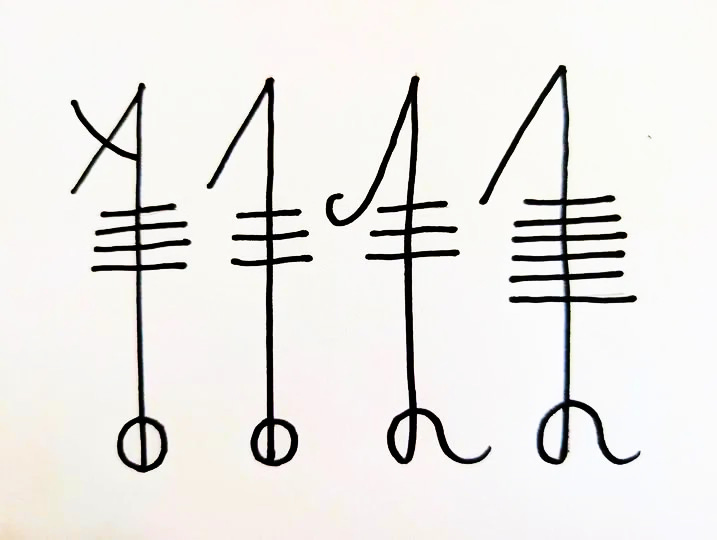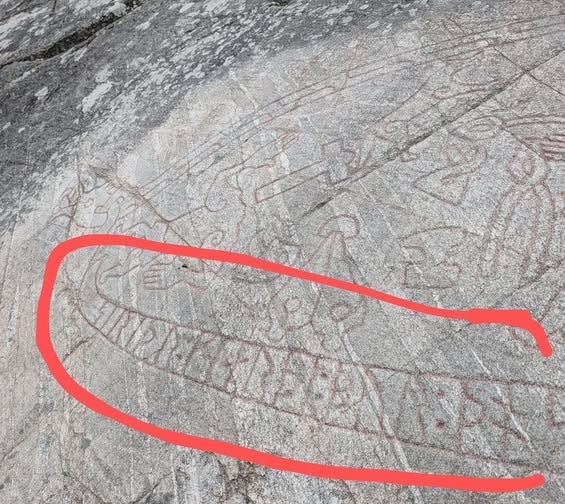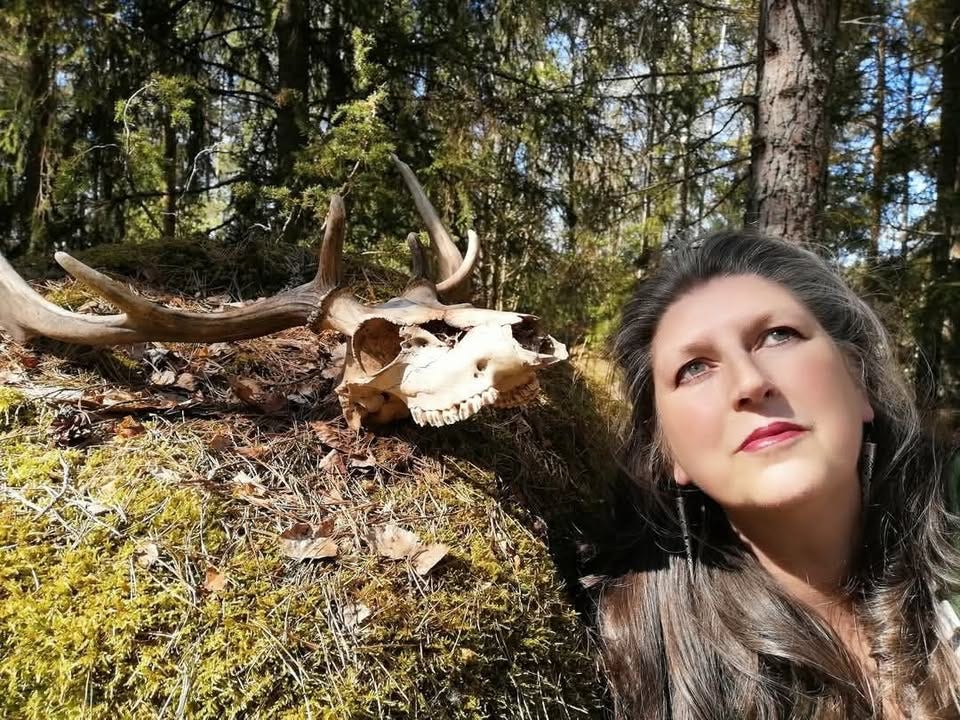Yesterday I finally got to visit the famous Sigurd Rune Carving outside Eskilstuna. It had been on my wish list for years!
This famous site is highly unusual, in a number of ways. It is an elaborate runic inscription (with the usual serpents used as ribbons containing the text), but created petroglyph-style: carved into a naturally smooth rock face.
This rock is situated in an extremely pretty rolling landscape, surrounded by trees, as shown below:
Who is Sigurðr?
Perhaps a little confusingly this massive inscription was commissioned by a woman called Sigrid (Sigrid - Sigurd). It depicts a famous Old Norse myth: the story of Sigurðr and the dragon called Fafnir, as told in the Völsunga saga (Saga of the Volsungs).
The most important works featuring Sigurðr are the Nibelungenlied, the Völsunga saga, and the Poetic Edda. Richard Wagner used the legends about Sigurd/Siegfried in his operas Siegfried and Götterdämmerung. Wagner relied heavily on the Norse tradition but ultimately created his own version of the Siegfried Saga. My Seiðr students sometimes think that the opera is true to to myth in every little detail, but it is not!
Here is the story in a nutshell: once upon a time Fáfnir was a young man. His father, Hreiðmarr, possessed a treasure hoard, given to him by the Norse gods Odin, Loki and Hœnir as weregild (financial compensation or blood money) for the killing of his son Ótr. One day Fáfnir seizes his opportunity: he kills his father and flees with the treasure hoard to a place in the wilderness called Gnitaheið. Here Fáfnir shapeshifts into a serpent or dragon (Old Norse: ormr or dreki).
Fáfnir has a brother called Regin, who forges a magical sword for Sigurðr. He persuades Sigurðr to kill Fáfnir. He gives Sigurðr a detailed plan: dig a pit and hide in it until Fáfnir slithers across the pit. Then strike him from below, straight into his underbelly. Sigurðr executes this plan. Regin then instructs him to cut out and cook the heart of the dead dragon. When Sigurðr checks to see if the meat is properly cooked, he burns himself and automatically sucks his thumb to alleviate the pain.
SIGURDR SUCKS HIS BURNED THUMB
In doing so he accidentally ingests some of the blood of the dragon. He discovers that all of a sudden he understands the language of birds! However, the birds are talking about how Regin will betray Sigurðr by murdering him, now that he has retrieved the treasure hoard. In good Old Norse fashion (strike before your enemy strikes!) he kills Regin instead, and loads up his horse Grani.
After that Sigurðr’s adventures continue. In the text of the Poetic Edda, as it appears in the Codex Regius, Sigrdrífumál (also known as Brynhildarljóð) follows on from the poem Fáfnismál seamlessly. Sigurðr encounters a Valkyrie (Valkyria)* called Brynhildr (also identified as Sigrdrífa meaning Victory Driver).
*I observe that in the field of Old Norse studies scholars now use the Old Norse word valkyria (Chooser of the Slain) instead of the English word valkyrie (to step away from the way “valkyries” are portrayed in many modern movies and media). I follow this convention in my own essays.
The Valkyria called Sigrdrífa had slain a warrior called Hjalmgunnar in battle, and Odin pricked her with the sleep-thorn as punishment. This put a sleep spell on Sigrdrífa and Sigurðr is the one to wake her up (after a very long time). In return Sigrdrífa shares her wisdom teachings with our hero Sigurðr , including guidance about using the runes (in relationships, battle and for personal protection).
SVEFNTHORN (Old Norse svefnþorn) or THE SLEEP THORN
Explanation: The most common depiction we have of the svefnþorn consists of four harpoon or spear-shaped figures. It first appears in the Huld Manuscript, a compendium of Icelandic magic recorded in the 1800s. The svefnþorn is the ninth spell in the Huld Manuscript. Here is the text: “This sign would be carved on oak and laid under the head of the one who is supposed to sleep so that he can not awaken until it is taken away.”
I often say to my students: “Don’t try this at home, it is not suitable for modern times!” but an old spell from Iceland reads:
Sleep thorn: Take the heart sac [pericardium] of a dog; pour pickling broth into it. Then dry it for thirteen days long, in a place where the sun does not shine on it, and when the one to whom you wish to do this is asleep, hang this in the house over him completely without his knowing it.
My understanding is that the “harpoon” sigil shown above was created by an Icelandic rune magician in the 19th century. I do not believe that it appears, in this exact form or design, in any earlier manuscript. Though we do have plenty of mentions of a thorny sleep spell in the sources!
Note some similarities to the fairy-tale of Briar Rose or Sleeping Beauty here. The “thorn rune” is THURS (Thurisaz).
Who commissioned the Sigurd Carving?
The Sigurd Carving tells the story of a powerful woman called Sigrid, who lived about 1000 years ago (so towards the end of, what we today call, the Viking Era). This was the century when Scandinavia became Christianised. Sigrid had a bridge built at this site. (Water levels were much higher then, the landmass of Scandinavia is still rising after the Ice Age). The carving mentions four men by name (Alrik, Orm, Holmger and Sigröd). In the Viking Age wealthy people had rune stones (or runic inscriptions) carved to honour deceased family members.
THE PART OF THE RUNIC INSCRIPTION DISCUSSED HERE
Alrik was Sigrid’s son and Orm (meaning Dragon/Serpent) was her father but archaeologists and linguists argue about the rest of the inscription! At that time the Old Norse people did not follow any standard spelling (or any universally agreed on grammar) but the consensus seems to be that the bridge was built for Holmger’s soul and that Holmger was Sigrid’s husband. The inscription informs us that Holmger was deceased when the inscription was created and that the bridge was built in his memory (and possibly for his soul to cross safely into the other world?) Sigröd was the son of Holmger and Sigrid. The inscription indicates that both Sigrid and Holmger were married before and that both had children from previous relationships (not mentioned by name on the stone). Based on what we know about women (especially wealthy widows) in the Viking Age, there is a strong possibility that Sigrid commissioned both the bridge and the carving from money that Holmger left behind. Therefore only their biological son and heir made it “into stone”.
ARTICLE FROM Sörmlands museum (IN SWEDISH)
There is still a lot of water in this area, even today. The site is near (but not on the shore of) lake Mälaren. There is a creek nearby with wooden bridges across it to fields and farms.
With my hand, for size comparison
Unfortunately this spectacular site is too far to take students here at my Forest School (the three hours of driving back-and-forth required would "eat up” too many hours of instruction time in class). Yesterday was definitely my lucky day, because I also stumbled across three rune stones I was not even planning to visit!
Any day that has a rune stone in it, is a good day in my life!
I will write more about runes and runic inscriptions as the publication of Portals, Patterns and Pathways (My Handbook for Rune Magicians) draws closer. A little bird has whispered in my ear that the cover is going to look especially exciting! We are talking about Spring 2026, but the exact publication date has not yet been set (only last week I was asked to make a few more “emergency illustrations”!) Rest assured that the Moon Books team is ON IT. It is coming!
I try (but sometimes fail) to get out at least one essay a week (sometimes more), due to travel, international teaching commitments and family care responsibilities (our family lives with Alzheimer’s and I have written several posts about that). If you would like to see regular posts about about Nordic spirituality and my life as a Forest Witch (and of course short videos of all the wildlife here!), please follow me on Instagram or Facebook, thank you! All artwork and photographs shared in my posts are my own, unless explicitly credited to a different source.
Imelda Almqvist, Forest Witch, Sweden
BIO FOR IMELDA ALMQVIST
Imelda Almqvist is an international teacher of Sacred Art and Seiðr/Old Norse Traditions (the ancestral wisdom teachings of Northern Europe). So far she has written four non-fiction books and two picture books for children. Natural Born Shamans: A Spiritual Toolkit for Life (Using shamanism creatively with young people of all ages) in 2016, Sacred Art: A Hollow Bone for Spirit (Where Art Meets Shamanism) in 2019, Medicine of the Imagination - Dwelling in Possibility (an impassioned plea for fearless imagination) in 2020 and North Sea Water In My Veins (The Pre-Christian spirituality of the Low Countries) was published in June 2022.
The Green Bear is a series of picture book for children, aged 3 – 8 years. The stories and vibrant artwork, set in Scandinavia, invite children to explore enchanting parallel worlds and to keep their sense of magic alive as they grow up.
Imelda has presented her work on both The Shift Network and Sounds True. She appears in a TV program, titled Ice Age Shaman, made for the Smithsonian Museum, in the series Mystic Britain, talking about Mesolithic arctic deer shamanism.
Imelda currently has a handbook for rune magicians (about the runes of the Elder Futhark) in production (it will be published by Moon Books in 2026). She is now working on a book about Inuit deities and mythology. Imelda runs an on-line school called Pregnant Hag Teachings, where all classes she teaches remain available as recordings, which can be watched any time.
Website:
http://www.shaman-healer-painter.co.uk/
YouTube Channel: youtube.com/user/imeldaalmqvist
Online School: https://pregnant-hag-teachings.teachable.com/courses/
Facebook: https://www.facebook.com/imelda.almqvist/
Instagram: https://www.instagram.com/almqvistimelda/












Share this post